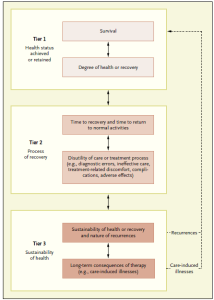July 31, 2015
Tell us: Who should be helping workers with health problems keep their jobs?
The US Department of Labor (DOL) wants to engage YOU in dialogue (you employers, insurers, physicians/healthcare providers, managed care companies — and working age individuals whose jobs have been affected by new or changed health conditions.) The dialogue concerns some draft recommendations for Establishing Work and Full Participation in Life as ACCOUNTABLE Health Outcomes.
The recommendations are part of a larger report I have drafted. It is focused on these questions:
1– How can we reduce the number of working adults who lose their jobs or leave the workforce after their ability to work has been disrupted by a health condition—and conversely, how can we increase the number who get the help they need to stay employed?
2– What will create widely-shared social agreement that preserving/restoring the ability to work and participate fully in life should be seen as KEY OUTCOMES of healthcare for the working age population?
3– Who should be helping working people KEEP THEIR JOBS after acquiring a new or changed disability? Who should be held accountable when they needlessly LOSE THEIR JOBS?
4– How can that accountability be established—for real?
The DOL’s Office of Disability Employment Policy (ODEP) commissioned this paper. Many ideas for how to accomplish those things emerged after interviewing about 20 experts in various fields and discussing these issues with a Policy Work Group within ODEP’s SAW/RTW Policy Collaborative. Because the stay-at-work and return-to-work process is by nature a “team sport”, the reality is that SEVERAL parties will need to be held accountable.
The draft report actually makes more than 20 detailed recommendations, but for now, ODEP would like to get feedback from YOU on the 6 main ones. This is a reality check, to see if we’re on the right track in your opinion. I ENCOURAGE you to disagree, make corrections, or suggest things that are missing or would strengthen the proposal. The purpose of this exercise is to IMPROVE the report – and increase the chances that it actually has a positive impact. The ultimate goal is to help more people stay in the workforce, remain productive contributors, and enjoy the many benefits of economic self-sufficiency and full social participation.
You can look at the recommendations on ODEP’s “crowdsourcing” website even before you decide whether to vote/comment. I hope you will. See the invitation from ODEP below to get started. Again, FEEL FREE to disagree, to point out mistakes, make additional suggestions, etc. etc.
From: Acting Assistant Secretary of Labor – Office of Disability Employment Policy
Sent: Wednesday, July 29, 2015 3:40 PM
Subject: ODEP’s Latest Online Dialogue Discusses Work as a Health Outcome
Second Stay-at-Work/Return-to-Work Online Dialogue:
Establishing Work and Full Participation as Accountable Health Outcomes
Do you have ideas on how to reduce the number of working adults who lose their jobs or leave the workforce after their ability to work has been disrupted by a health condition—and conversely, how to increase the number who get the help they need to stay employed? If so, the U.S. Department of Labor’s Office of Disability Employment Policy (ODEP) needs to hear from you!
ODEP is hosting the second in a three-part series of important online dialogues, Establishing Work and Full Participation as Accountable Health Outcomes, to gather input on policy recommendations aimed at establishing work and full participation in life as accountable health outcomes. Through the use of an online crowdsourcing tool, interested stakeholders can provide feedback on these six draft policy recommendations.
Participation is easy. Just review the policy recommendations, register, then share your feedback.
Visit http://WorkAsHealthOutcome.ePolicyWorks.org/ before the dialogue closes on Friday, August 14th. If you have any questions, please contact ePolicyWorks@dol.gov.
Looking forward to your participation,
Jennifer Sheehy
Acting Assistant Secretary of Labor for Disability Employment Policy

